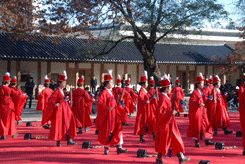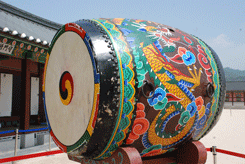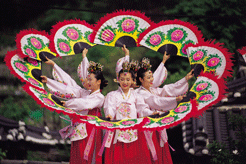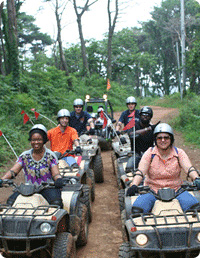INCENTIVE
Seoul 4 days



Day 1 Arrival (D) 60km
On arrival, a private transfer to the hotel of choice. During the check in, a welcome drink is served, followed by a folk art pillow gift.
With time to relax, modern Korean fusion dinner is planned.
Day 2 Seoul (B L D)
Today, you have a choice of tours of your preference.
Seoul city tour (6 hours)
Your exploration this morning begins with a driving tour of Seoul, featuring sites such as Seoul Plaza, City Hall, Cheonggye Square and pedestrian-friendly Gwanghwamun Plaza hemmed in on both sides by rushing traffic and office buildings. On this plaza stands a statue of Yi Sunsin who had engaged in twenty-three naval battles and emerged victorious in all of them during the Hideyoshi invasion (1592-1598). King Sejong who propagated the Korean alphabet in the 15th century is also honored with prominent statue. Near the plaza is Korea's Kilometer Zero, marking the distances to 64 cities around the world, including Seoul's antipode, Montevideo, Uruguay, 19,606km.
Step back in time to when life was gracefully slow and enjoy Gyeongbokgung Palace, a particularly charming spot that represents a colorful and turbulent side of the capital's 500-year history. Depending on timing, you may witness the Royal Guard Changing Ceremony featuring parade, password verification, duty shift and patrolling the gate. Accompanied by a court band with its colorful costumes and royal flags, the ceremony is performed daily basis at 10:00 and 14:00 except Tuesdays, although it is cancelled in case of rain or extremely hot or cold weather.
Your visit to the National Folk Museum of Korea will familiarize you with wealthy culture of this friendly and picturesque nation. Learn about the culturally historical daily life of the Korean people from the prehistoric age to the Joseon dynasty. The permanent exhibition features life and work, costumes and ornaments, handicrafts and technology, educations, living quarters, dietary life, oriental medicine, performing arts and games, beliefs and rituals, and
socio cultural life.
You will tour the centuries-old Namdaemun Market brimming with well over 11,000 shops selling anything you can imagine. The whole area is a labyrinth of street vendors and buildings. The market is seriously crowded, so be prepared to get bumped around. A fantastic place to haggle over the price to get the best deal on something you want or simply admire the vibrancy of this massive market. At the western entrance of the market in the middle of a traffic circle stands Sungnyemun. It is a formidable and iconic construct that served as the southern gate of the wall that surrounded Seoul during the period of the Joseon Dynasty.
Barbecued beef (Bulgogi) is planned for your lunch.
Bulgogi is a beautiful marinade of small pieces of beef, eaten rolled in lettuce and sesame leaf with chili and a sample of side-dish or two. Bulgogi is made from thin slices of sirloin or other prime cuts such as top round which is chosen because it is marbled with a little fat but not too much. Whatever the cut, the meat is marinated for at least four hours in a mixture of sesame oil, soy sauce, black pepper, garlic, sugar, onions, ginger and some wine. Bulgogi is grilled with whole cloves of garlic and served along with lettuce or other leafy vegetable which used to wrap a sliced of cooked meat, with Ssamjang as a dipping. Place this inside a lettuce leaf with other shredded salad vegetables and roll the whole thing up into a bite size mouthful. Use the dipping sauces provided to complete the experience.
You are treated to a delightful evening at Korea House with Korean Hanjeongsik followed by traditional music and dance. You will enjoy a multi-course meals that please your appetite featuring everything from the appetizer or colorful rollup dishes of nine ingredients all wrapped in wafer-thin rice pancakes that may be served in a Gujeolpan. Various savory dishes are served in series rather than all at once which is more traditional style. What you see is what you get. Some of the dishes served in Hanjeongsik generally includes squash porridge, salad, rice and soybean paste stew, mung bean jelly, grilled shrimps, steamed shrimps, grilled scallions, grilled codfish, zucchini pancakes, assorted glass noodles, ginseng in honey, sauteed mushrooms, braised short ribs, bamboo shoots, and vegetables in a persimmon dressing, kimchi, pickled plums. Sinseollo is also served. It is a casserole, an elaborate chowder-like stew consisting of meatballs, small and round pancake-like dishes, mushrooms, and vegetables cooked in a rich broth. It is served in a large bundt pan shaped vessel with a hole in the center, in which hot embers are placed to keep the dish hot throughout the meal. The ingredients are placed around the pot according to color. Nuts and other delicacies accompany the meat, fish and vegetables in one pot. It provides an array of flavors and nutrients. After the meal, fruit and tea or punch may arrive as dessert. Hanjeongsik can be the fullest and best expression of what Koreans value in the food.
Following dinner, you will be mesmerized with a traditional music and dance. One particularly fantastic performance is the fan dance. It originated from a folk ritual dance, in which a fan is employed in a dance that is both strong and passionate in artistic effect. The colors, movement, and lyrical melodies are truly a delight, and you are in awe of the rhythmic dancers and their visual masterpiece with their fans. Such perfection and grace is rarely seen. Other performances may include Pansori, a traditional Korean opera, a traditional shamanism dance, farmer's music and dance, or other traditional music. The tour offers an excellent opportunity to touch the feelings of Korean culture and glimpse a slice of Korean tradition of old Korea.
The 3rd Tunnel tour (6 hours)
Please note that the DMZ is a politically sensitive area, and is therefore not always open to tourists.
In the event that the area cannot be visited, alternate sightseeing will be arranged.
The 3rd Tunnel tour
| Rules and Regulations * No tour on Monday and public holidays * Full Name, Passport number, Date of Birth and Nationality must be received at the time of booking * You are required to bring your passport * Picture taking is prohibited upon boarding the tour bus at Imjingak * Persons who suffer from claustrophobia, heart conditions or asthmatic symptoms are not allowed to enter the tunnel * Depending on crowd size, tunnel tour might be done before the video * Walking the tunnels are not required, guests may opt out and choose to stay on the bus, exhibition room or souvenir store * Visitors are not allowed on an individual basis, it is necessary to join the group * A private bus is allowed only if 30 or more passengers travelling together on the same bus |
 Your touring today will be private today until you reach Imjingak, at which time you will board a bus with other tourists as private tours of the tunnel and DMZ area are not allowed. Your private tour guide will remain with you throughout the day.
Imjingak is the furthest north point in the area than you can go freely, and a park with an array of monuments and statues that speak to the Korean War (1950-1953). One such monument is Mangbaedan, a memorial site where displaced North Koreans pray for their ancestors. Near Mangbaedan is the Freedom Bridge, and was an important site where 12,773 prisoners of war returned to freedom. This short, sturdy wooden structure ends at a barricade, which embodies the North. The altar and the bridge now serve as places of remembrance for displaced families, and the millions of bright colored ribbons tied to the fence have messages of hope, dreams and wishes for unification between South and North Korea.
Your touring today will be private today until you reach Imjingak, at which time you will board a bus with other tourists as private tours of the tunnel and DMZ area are not allowed. Your private tour guide will remain with you throughout the day.
Imjingak is the furthest north point in the area than you can go freely, and a park with an array of monuments and statues that speak to the Korean War (1950-1953). One such monument is Mangbaedan, a memorial site where displaced North Koreans pray for their ancestors. Near Mangbaedan is the Freedom Bridge, and was an important site where 12,773 prisoners of war returned to freedom. This short, sturdy wooden structure ends at a barricade, which embodies the North. The altar and the bridge now serve as places of remembrance for displaced families, and the millions of bright colored ribbons tied to the fence have messages of hope, dreams and wishes for unification between South and North Korea.
You can also see a derelict locomotive engine shot full of bullet holes and its bent wheels - not particularly special in any way other than it shows the destruction of war. Having been left in the DMZ since bombs derailed it during the Korean War; it was cleaned up and moved here in 2009. There is a collection of stones from 86 battlefields in 64 countries known as the Peace Stones that have witnessed suffering and grief of war.
Then, you board a bus to continue with other tourists on to the Demilitarized Zone which straddles the South and North Korean border. A 4km wide buffer of land stretches the breadth of the Korean peninsula. Although an Armistice came into effect in July 1953, the two Koreas are still technically in an active state of war. Tensions between the two countries remain high, and the border is patrolled by thousands of troops on both sides.
DMZ has strict security measures, passports need to be cleared at the Unification Bridge, the first control line with sentries and photo opportunities will be limited.
The tour stops at DMZ Theater and Exhibition Hall for a short video including old film that takes you back in time to the signing of the armistice and the creation of the DMZ. Displayed in the exhibition hall are model of soldiers digging the tunnel, equipment used by the North, model of Panmunjeom (or Joint Security Area), a timeline of major North Korean provocations over the South since 1950, and photographs of the historical events about Korea's division.
The 3rd tunnel is one of the four infiltration tunnels dug by the North that have been discovered by the South on October 17, 1978. It is a 1,635m long, 2m high and 2m wide, and could have accommodated 30,000 soldiers per hour in what was apparently designed for a surprise attack on Seoul. The tunnel runs through bedrock at a depth of about 73m below ground; 435m of which are found in the South over the Military Demarcation Line. It is designed at a three thousandth angle with northern side lower than southern side, so that water does not stagnate inside tunnel. You can clearly see the drill marks for dynamite all pointing toward the South. This finding, along with other clues, clearly affirmed their construction.
The tunnel, which is now well guarded, though it is a busy tourist site, where you enter either by walking down a long steep incline and of course up again or via a sled on rails that contains a driver in up to groups of thirty or more on reservation basis. After ducking and crouching your way 265m through the tunnel, you will reach one of the cement walls with iron door near the Military Demarcation Line that will prevent you from going any further north and where you peep through a small window at a barricade, just to see another barricade in the distance.
Situated on top of Mount Dora, the Dora Observatory looks across the Demilitarized Zone with a South Korean flag in Daeseong-dong near Panmunjeom and a North Korean propaganda village, Gijeong-dong where 270kg (35m x 28m) North Korean flag hangs on a 160m-tall jamming tower and North Korean city of Gaeseong. In 1981, the South Korean government built a 99.8m-tall flagpole with a 130kg (18m x 12m) South Korean Flag. The North Korean government responded by building what was then the tallest flagpole in the world at 160m, in what some have called the "flagpole war”. The flagpole was superseded as the world's tallest, following the construction of the flagpole in Baku’s National Flag Square at 162m. Both flagpoles were topped in 2011 by the Dusanbe Flagpole in Tajikistan at 165m.
You will also tour the Dorasan Station, the last railway station in South Korea before the North Korean border. This station drew world attention when President Bush visited here in February 2002. On December 11, 2007, freight trains began traveling north past this station into North Korea, however, on December 1, 2008, the North Korean government closed the border crossing. The station is heavily guarded and signs are up showing the future destination of Pyeongyang in North Korea. The milepost "Seoul 56km/Pyeongyang 205km" still stands from the time when trains could still cross past this station and into North Korea.
Barbecued beef (Bulgogi) is planned for your lunch.
You are treated to a delightful evening at Korea House with Korean Table D'hote dinner followed by traditional music and dance.
Korean Folk Village (6 hours)
It is a functioning community displaying the diversity of Korean lifestyle and culture of several centuries ago. Experience the heritage of the Korean people and soak up the local culture.
At village entrance stands an eye-catching stone tower topped by a symbolic stone serving as fertility and protective totem, where people write a wish on the paper and tie to the ropes.
On entering the village, you are greeted by goofy looking group of wooden Jangseung signifying village boundary and preventing bad luck.
Today, you will explore a wide assortment of residential structures from the straw-thatched cottages of commoners to the 99-room mansions of the noble class as well as governor's office. The village also shows workshops of 20 types where the real artisans and craftsmen dressed in traditional costumes ply their trades, demonstrating centuries-old craftsmanship in the art of pottery, pyrography, bamboo craft, Korean paper, brassware, and many more. While strolling past the houses and workshops one by one, you will get the feeling of walking through time in an ancient village.
Time works out, enjoy farmer's music and dance, which has been the beloved form of entertainment of Korean people, bearing testimony to the gregarious character of Korean fun-making and festivity. Jultagi or acrobatics on a tightrope is something you cannot miss. The rope walker executes a variety of acrobatic feats on the rope, along with jokes, mimicry, or songs, while a clown engages the tightrope walker in joking banter, and a team of musicians plays music to accompany the entertainment.
You will also experience some of long-observed seasonal customs, beliefs, folk games or plays that have been comprehensively reflected the daily life of the Korean people. A traditional wedding ceremony is also performed on a daily basis, although it may no longer be explicitly followed.
Barbecued beef (Bulgogi) is planned for your lunch.
You are treated to a delightful evening at Korea House with Korean Table D'hote dinner followed by traditional music and dance.
Day 3 Seoul (B D)
Today's program is designed to fit your interest, allowing you to choose the program you prefer. In that we suggest some of the attractions to choose from. The tour may not be avaialble or switched when the date falls on their individual closing days.
National Museum of Korea
It showcases artifacts from the origins of Korean society, allowing you to experience Korea's unique culture that has evolved through time. The museum displays relics and artifacts by chronological order, Prehistory and Ancient History Gallery, Medieval and Early Modern History Gallery, Calligraphy and Painting Gallery, and Sculpture and Crafts Gallery. After the historical tour at the ground floor, you will see and experience the beauty of Korean arts on the second and third floor through a wide variety of artworks and cultural properties.
The unprecedented gathering of the outstanding artifacts will provide you with an opportunity to appreciate the superiority and delicacy of Korean ancient sculptures, paintings and arts of all types.
Leeum Museum
Leeum houses the comprehensive collections of traditional and contemporary art of Korea. Dedicated to being the foremost Museum in Korea to bridge the country's artistic heritage with its contemporary art practices, Leeum is an ever evolving and dynamic institution committed to establishing the finest permanent collections and temporary exhibitions. Three buildings make up the composite complex. MUSEUM 1 is devoted to the exhibition of traditional Korean artwork. MUSEUM 2 showcases modern and contemporary works by both Korean and foreign artists. Finally, the Samsung Child Education & Culture Center supplements the two Museums by contributing to the cultural education of our future leaders. This cultural complex was designed by three internationally acclaimed architects, Mario Botta, Jean Nouvel and Rem Koolhaas.
Korea Furniture Museum
Overall in an hour's tour, you will get a glimpse into a Korean tradition and also culture, featuring a number of Hanok houses with some 2,000 pieces of Korean wood furniture. The facility is the most comprehensive private museum of its kind and is dedicated to provide insight understanding into traditional Korean lifestyle. Yet, the architecture built in traditional Korean style, is a striking feature that simply cannot be missed parallel to the furniture collection. Display rooms categorized by type and era of the furniture are on the basement levels, while the ground floor expo explains how the furniture was placed in its original settings within a Hanok.
The tour of the house offers more than just taking a peek into the lifestyle of upper-class people of the Joseon period. One can learn about the size and proportion of Joseon furniture which are calculated in accordance with the size and proportion of windows and walls of private residences. Chagyeong is well introduced to one of the residences. Chagyeong literally means ‘appropriative landscape’ or ‘borrowed scenery’, refers to a design method which uses or appropriates distant scenery as a part of my own landscape by positioning the building and windows for the view. Reservation is required however the rules of visiting this museum are very tight.
Temple Life Experience (L)
There are many temples in Korea, but the opportunity to observe and experience the ascetic Buddhist life in a temple does not come easily to outsider visitors. Some of the temples in Korea open their doors to foreign visitors for a short sojourn to give visitors the opportunity to see how monks practice their daily discipline from early morning prayers to evening rites. You will get to study and experience the Korean tradition and culture, all at the same time enjoying the nature. Temple program may vary due to season and conditions of the individual temple situation, but it basically includes meditation, tea ceremony, lotus lantern making or prayer bead making. You will experience temple meal, perhaps first time in your life.
Modern Architectures
On an introductory driving tour of Yeouido, an emerging residential neighborhoods and commercial developments including some of the significant buildings, you will see Full Gospel Church possibly the largest in the world, the massive National Assembly Hall built in the mid-1970s, towering 63 building and S-Trenue, a landmark skyscraper with its Bundle Matrix, Stocky Tower and Podium Tower topped by Sky Garden.
While in Gangnam, explore a number of modern buildings. Urban Hive is the winner of the grand Seoul Architecture Award 2009. With 105cm-diameter holes on the white concrete walls, the building looks like a hive. The building exposes its concrete structure, exposing the many holes inside which resemble a sponge.
As you drive, see Kyobo Tower majestically rising in Gangnam's busy intersection, a typical of the works of Mario Botta. Gwell tower with its 32 office unit having an outdoor space that creates a unique "eroded" appearance is a very simple glass curtain wall tower, giving each its own characteristic.
Boutique Monaco is an office building designed to have more exterior surface and corners for more natural light and better views. The spaces created by the missing matrixes are landscaped with trees that are visible from the inside and outside of the building.
Then pass by Samsung Headquarters. Inspired by the symbolic joinery represented in traditional Korean woodworking, these complex curtain wall systems allow for maximum control by the occupants over day lighting and natural ventilation, minimizing the amount of artificial lighting, heating and cooling required by the buildings.
A driving tour goes through the 3.5km-long Teheran-ro, or Teheran Boulevard and see various modern building including POSCO, Offices and Banks. Some of Korea's tallest skyscrapers and most expensive real estate are largely centered here. You will then tour the Lotte World Tower, a 555-meter monument to Seoul’s skyline reaches heights never before seen in Korea and joins the ranks of the world’s top ten tallest buildings, being the tallest building in the OECD, and is the 5th tallest skyscraper in the world.
The sleek tapered form of the 123-story tower stands out from the city's rocky mountainous topography near the Han River. An exterior of pale-coloured glass draws inspiration from Korean ceramics and features accents of metal filigree.
Balance of the day at your own pursuit, You can explore the city yourself or look for souvenirs.
Evening is highlighted with broiled short beef ribs (Galbigui).
Galbigui requires quite a bit of preparation but the end result is a finger licking. The short beef ribs are marinated overnight in a mixture of green onions, garlic, sugar, sesame oil and soy sauce. Rice wine and oriental pear can also be added for extra flavor. The marinade helps to tenderize the meat which is then grilled over charcoal or gas at the table in front of you. A dipping sauce consisting of sesame oil, ground black pepper and salt often accompany Galbigui. A common way to consume the meat is to place a slice inside a lettuce, perilla or other green leaf with Ssamjang, a paste made out of chili pepper and soybean paste. Strong flavors and seasoning, colorful presentation, informally served and eaten - just Korean way of dining experience. Later, a bowl of rice along with Doenjang Jjigae (bean paste stew) which is not overly salty, a slight sweetness or cold noodle served on request are among the popular menus ending the course.
Day 4 Departure (B) 60km
With time to reflect on your surprise in your experience of Korea, transfer to the airport in time for your flight.






